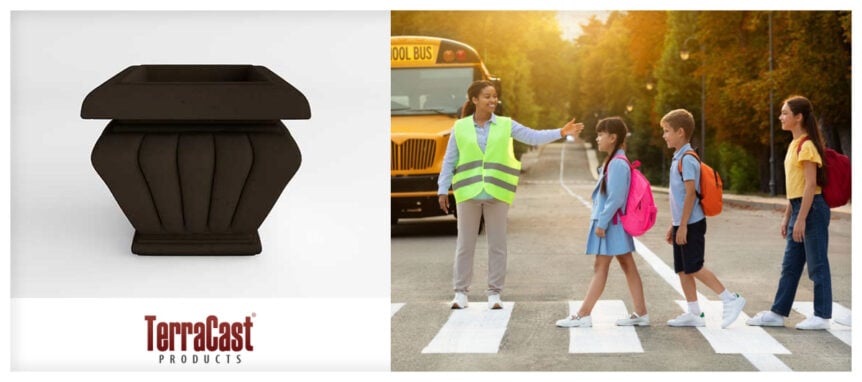As students return to school each fall, municipalities, urban designers, and safety advocates turn their attention to a critical shared goal: creating safer school zones. While signage is a key component—alerting drivers to slow down and stay alert near children—effective design goes far beyond posted speed limits and flashing lights.
Safe school zones depend on a combination of visual cues, physical infrastructure, and environmental design to influence behavior and ensure children, parents, and staff can travel safely to and from school. As cities explore smarter, more effective approaches to these high-traffic areas, site furnishings and planter-based infrastructure are emerging as essential tools in the effort to create intuitive, walkable, and secure school environments.
Designing for Visibility and Clarity
Clear visibility is one of the most important principles in school zone safety. Drivers must be able to see pedestrians, bikers, crossing guards, and each other without obstruction. At the same time, the environment should be visually structured to reinforce where cars should go—and where they shouldn’t.
Planters are often used to define pedestrian corridors, prevent vehicles from mounting curbs, and reduce the visual clutter that can occur with too many signs or temporary cones. Their consistent placement along sidewalks and crosswalks draws clear boundaries between pedestrian and vehicular zones without the harshness of fencing or barricades.
Colors also play a critical role here. Lighter-colored or high-contrast furnishings can draw attention to critical zones, helping both children and drivers recognize key areas. Warm tones and school-themed designs make the environment feel welcoming rather than restrictive, promoting positive behavior without visual aggression.
Creating Physical Separation Without Hard Barriers
In areas where space is limited, achieving physical separation between walkways and roads can be difficult. Installing permanent barriers may not always be an option, especially in school zones that also serve as community gathering spaces or play areas.
TerraCast® resin furnishings offer a middle ground between aesthetics and functionality. Strategically placed planters can serve as natural barriers without disrupting the look and feel of the neighborhood. These objects help guide traffic and prevent unsafe drop-offs, while also enhancing the environment with greenery or useful amenities.
Unlike concrete or metal alternatives, resin furnishings are lightweight and movable, allowing municipalities to reconfigure the layout as student needs or traffic patterns evolve. They can be temporarily repositioned during events or construction and returned to their usual placements without specialized equipment or costly labor.
Encouraging Walkability and Community Use
Safe school zones aren’t just for pick-up and drop-off times. These are community spaces—used for after-school activities, weekend programs, and neighborhood gatherings. Encouraging pedestrian use throughout the day improves passive surveillance, reduces crime risks, and creates stronger connections between students and their surroundings.
To promote this kind of use, school zones must feel inviting, not just regulated. Comfortable seating, functional trash collection, and thoughtful landscaping signal that the space is intended for people, not just vehicles. Resin furnishings help achieve this by blending into school-appropriate aesthetics while withstanding heavy daily use.
Unlike wood, resin doesn’t require constant repainting or sealing. Unlike metal, it doesn’t rust or heat up in the sun—making benches and tables safe to use year-round. With UV protection and graffiti resistance built in, these products continue to perform and look great even in the most active environments.
Reinforcing Safe Habits Through Environmental Cues
Children learn by observing their environment. When school zones are thoughtfully designed, they subtly teach students about safe behavior: where to walk, how to wait, and how to interact with traffic. This kind of “environmental guidance” is most effective when the physical space reinforces the behaviors expected from users.
Using planters to funnel foot traffic toward designated crosswalks, or positioning benches near supervised waiting zones, encourages orderly habits. Children naturally follow the paths created by visual cues and consistent boundaries, even before they can read the signs posted around them.
Custom-colored resin furnishings can also align with school branding or district-wide initiatives—subtly reminding students that their safety and behavior matter without relying entirely on rules or enforcement.
A Modern Approach to School Zone Safety
Modern school zones must balance form and function. They need to keep children safe, accommodate traffic flow, and support community use—all while staying within municipal budgets. Traditional infrastructure upgrades can be costly and disruptive, but incorporating durable, attractive resin furnishings is a cost-effective way to improve safety, aesthetics, and usability at the same time.
As cities continue to prioritize Vision Zero goals and invest in safer urban environments, school zones offer a valuable starting point. By going beyond signage and embracing intentional, human-centered design, planners can create school environments that not only protect—but also inspire—the next generation.
Ready to enhance your school zones with long-lasting and flexible resin solutions? Reach out to TerraCast® to explore our complete line of site furnishings and planters designed for public safety and performance.

